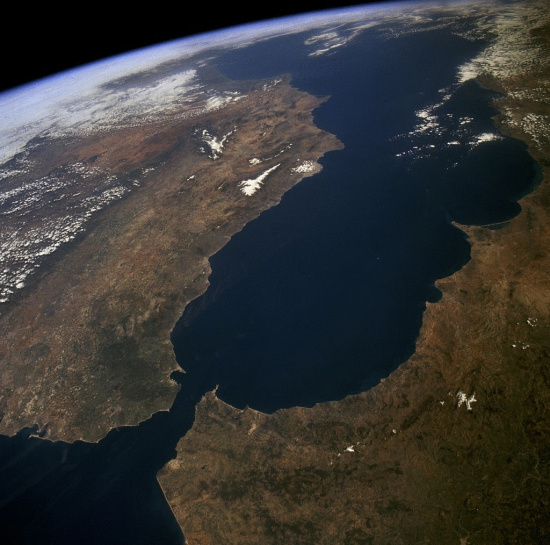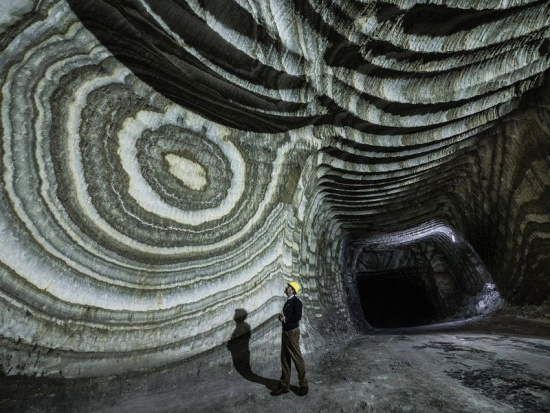Patmos, Greece (Barry Evans)
Anyone who has visited Europe has probably spent some time on the Mediterranean, known as the “Cradle of Civilization” for all sorts of good reasons. Think of the Phoenicians, Egyptians, Greeks and Romans (not to mention the Johnny-come-lately Umayyads, Byzantines, Venetians and Ottomans) and you’ve pretty much summed up the major influences on what we optimistically call “Western Civilization.”
Satellite image of the Mediterranean looking east across the Strait of Gibraltar: Spain on left, Morocco on right. (NASA)
Today, the Mediterranean is a million-square-mile puddle with average depth of one mile (three miles maximum), whose volume comprises about three tenths of one percent of Earth’s liquid water and stretching approximately 2,500 miles east to west by 500 miles north to south. It’s open to the Atlantic via the nine-mile-wide Strait of Gibraltar between Plato’s “Pillars of Hercules. That’s at the west end. At the southeast corner, Ferdinand de Lessep’s 120-mile-long Suez Canal (opened in 1869) leads to the Red Sea and the Indian Ocean.
Suez Canal, linking the Mediterranean (top) with the Red Sea (below). (NASA)
De Lesseps was beaten to it, by over two millennia. Darius I of Persia, conqueror of Egypt around 500 BC, had a canal built so that, “Therefore, when this canal had been dug as I had ordered, ships went from Egypt through this canal to Persia, as I had intended,” according to the Chalouf stela, now in the Louvre.
But all this nearly didn’t happen. Had it not been for a geological fluke, what today is the Mediterranean Sea would have been the Mediterranean Desert. Six million years ago, the tectonic plate carrying the African continent collided with the Eurasian plate where the Gibraltar Strait is today, cutting off the Med’s access to the Atlantic. Then, as now, evaporation from the Mediterranean Sea is three times the net inflow from rivers and rain. Normally, water from the Atlantic continually tops up the Med, but when the channel was plugged, the entire Mediterranean basin evaporated, turning the sea into a vast salt desert.
On Sicily’s southern coast, salt is mined commercially from deep beds at Realmonte—we’re talking miles thickness of the stuff!—that underlie today’s green landscape. (Giuseppe Fallica/500px)
Had the plug remained in place, the area we call the Mediterranean would today be a barren wasteland. No sea to support Phoenician trimarines or Roman galleys, no place for civilizations to rise (and fall). No rich history of invention and mathematics and writing. No Iliad or Odyssey. No pyramids, no Parthenon, no Forum. Nowhere for Judaism or Christianity to emerge as world religions. Western Civ would have been a bleak affair.
But of course, it didn’t happen that way. About 5.3 million years ago, a huge earthquake hit and the plug gave way, allowing the Atlantic to roar back into the basin. One theory—the “Zanclean Deluge”—holds that it took less than two years for a million cubic miles of Atlantic Ocean water to flood into the basin, at a flow rate 1,000 times that of today’s Amazon River.
And the rest, as they say, is history.
###
Interested in learning more about the Med? I’m giving a one-evening slideshow “Mediterranean Magic” through HSU’s OLLI program this Wednesday, 6-8 pm at the Humboldt Bay Aquatic Center. Call 826-5880 or online at www.humboldt.edu/olli for details.




CLICK TO MANAGE